India’s biodiesel industry is expanding rapidly in response to rising fuel demands and government support for cleaner energy. But beyond the main product lies an often-overlooked opportunity: crude glycerin, that humble byproduct of biodiesel plants.
In 2025, this “waste” is emerging as a high-value asset. The global market is on a promising track to achieve a 5.3% CAGR (2023 – 2034). And right here in India, where biodiesel plants are multiplying, the real game-changer is glycerin purification technology. Imagine transforming that raw, impure glycerin into premium, refined grades suitable for pharmaceuticals, cosmetics, and even food applications. Suddenly, you’re not just producing fuel – you’re unlocking entirely new revenue streams and supercharging your bottom line.
We will explore why glycerin purification plants are in high demand this year, how the economics work, and why adding one alongside your biodiesel unit can turn operational waste into a strategic business advantage.
Table of Contents
ToggleCrude Glycerin: Turning Waste to Wealth
Every metric ton of biodiesel produced yields approximately 100 kilograms of crude glycerin. Initially treated as a low-value byproduct, crude glycerin often contains impurities like methanol, water, salts, and soaps, which limit its commercial use. Unpurified, it sells at a low price and contributes to disposal challenges.
But the landscape is changing. Purified glycerin, especially USP-grade with 99.5% purity, commands a significantly higher market value. While crude glycerin may fetch INR 90 to 120 per kg, refined glycerin can reach INR 140 or more, depending on market and quality.
The transition from waste to wealth lies in purification. By setting up a glycerin purification unit, producers can turn a disposal headache into a steady revenue stream. This not only improves overall plant profitability but also supports waste valorization and environmental sustainability, making the operation more robust in the face of rising production costs and tighter environmental norms.
Crude glycerin, once an afterthought, is fast becoming a key component of biodiesel economics in India. In 2025, forward-thinking producers are no longer ignoring it; they’re monetizing it.
Market Momentum: Why 2025 Is the Right Time to Invest
The global glycerin market is expanding rapidly, valued at approximately $ 3.84 B in 2024, projected to reach around $4.04 B in 2025. Within this, refined glycerin accounted for 68% of the market in 2024, growing at around 4.9% annually through 2030. Biodiesel remains the dominant feedstock, contributing roughly 60% of glycerin supply in 2024, positioning India as a growing biodiesel hub, to benefit directly.
In India, the refined glycerin industry is gaining attraction as domestic demand from the pharmaceutical, personal care, food, and chemical sectors grows rapidly. The country produced over 200,000 metric tons of crude glycerin in 2023, with volumes rising on the back of expanding biodiesel production and feedstock diversification (used cooking oil, palm stearin, rice‑bran oil).
Prices have skyrocketed, retail glycerine prices in India rose 44% over 13 months, reaching ₹102.5/kg (~USD 1.23/kg) by June 2025, driven by tight supply and strong demand across pharma and personal-care industries.
What makes 2025 uniquely attractive for investors is this alignment of supply and demand:
- Abundant raw material: Growth in biodiesel under India’s National Policy on Biofuels and blending mandates is creating a steady stream of crude glycerin.
- Domestic and export opportunities: India exports refined glycerin to Southeast Asia, Europe, and the Americas, with consumers tracking Indian excipient quality and cost-effectiveness.
- End-user demand: Personal‑care alone held 32% of refined glycerin revenue in 2024 and is expected to grow at 4.8–5.2% CAGR, while pharmaceutical segments increasingly require USP‑grade glycerin.
Meanwhile, the Asia‑Pacific refined glycerin market is expanding steadily, from $2.12 B in 2024 to an estimated $2.17 B in 2025, on track for long‑term growth on rising industrial demand.
This combination of a growing supply of crude glycerin, rising domestic industry demand, favourable export potential, and tight local pricing makes 2025 a strategic inflexion point.
For biodiesel plant investors, adding a glycerin purification unit now means transforming a low-margin byproduct into a high-value revenue stream, capitalizing on surging domestic demand and export markets while future‑proofing operations in a sustainable, circular‑economy model.
How Glycerin Purification Enhances Biodiesel Profitability
For biodiesel producers in India, glycerin purification is no longer just a sustainability measure; it’s a smart business decision. As production volumes rise under India’s biofuel blending mandates, the volume of crude glycerin generated as a byproduct also increases.
By installing purification infrastructure, producers can convert this byproduct into a new profit center, increasing both revenue and operational efficiency.
Revenue Boost Through Value Addition
Crude glycerin typically contains 40–75% glycerol and sells at a discounted rate due to impurities like methanol, water, salts, and soaps. In contrast, refined glycerin, especially pharmaceutical or USP-grade (99.5%), commands up to 30–50% higher prices.
This value difference means that the same raw material, when purified, can earn substantially more per kilogram. Over time, this price premium translates to a meaningful revenue channel that supports the core biodiesel business.
Cost Efficiency & Waste Valorization
Glycerin purification enables waste valorization, turning a low-value byproduct into a high-demand commercial product. Instead of spending on proper waste disposal or selling crude glycerin at marginal rates, producers can monetize it. This offsets operating costs of biodiesel production, especially in periods when fuel prices are volatile or feedstock costs rise.
Purified glycerin also improves resource utilization efficiency, aligning with ESG (Environmental, Social, Governance) goals and reducing waste footprint, an advantage when applying for green financing, subsidies, or ISO certification.
Shorter Payback, Long-Term Gain
The capital expenditure for a purification unit varies by capacity and technology used (e.g., vacuum distillation, ion exchange, membrane filtration). However, the payback period typically ranges from 2 to 4 years, depending on production scale and output purity. As glycerin prices stay high in 2025 and beyond, this ROI window becomes even more attractive.
Access to Premium Markets
High-purity glycerin opens the door to pharmaceutical, cosmetic, and food industries, all of which demand stringent quality standards and offer better pricing and longer-term contracts. These sectors are less prone to market volatility than fuel, allowing producers to diversify risk and build predictable revenue flows.
In summary, adding a glycerin purification unit is not just a side project; it’s a core strategy to enhance profitability. It helps convert a reactive biodiesel operation into a vertically integrated, value-maximizing business. In a competitive biofuel market, that edge can define long-term survival and success.
Proven Technologies & Flexible Investment Options: Ideal for Glycerin Purification
Setting up a glycerin purification unit today is far more approachable than it was a decade ago. Thanks to maturing technologies and modular investment options, producers can choose purification systems that match their scale, purity goals, and budget. Whether you operate a small biodiesel unit or a large-scale integrated facility, there’s a proven solution that fits.
Popular Purification Technologies
The core goal of purification is to remove methanol, water, salts, soaps, and other contaminants from crude glycerin to meet industrial or pharmaceutical-grade standards. These are the most widely adopted technologies:
- Vacuum Distillation: The most popular technique, especially for high-purity output. It separates components based on boiling points under reduced pressure, preserving glycerin quality and reducing thermal degradation. Ideal for pharmaceutical or food-grade applications.
- Ion Exchange Systems: Effective for removing ionic contaminants like salts and soaps. These systems use resin beds to purify glycerin after initial evaporation or filtration. Often used as part of multi-stage purification setups.
- Membrane Filtration: A newer method gaining popularity for its lower energy consumption and continuous operation capabilities. It filters out contaminants based on molecular size and is suitable for medium-scale producers.
- Combined/Multi-Stage Systems: Increasingly common, especially among larger producers. These setups combine distillation, ion exchange, and filtration for optimal throughput and consistent purity.
Scalable Investment Options
Investment size varies widely depending on capacity and output requirements:
- Small-scale units may start with basic filtration and evaporation systems, ideal for biodiesel plants processing a few metric tons per day. These offer a low-cost entry point into glycerin purification.
- Medium-scale plants are the most common in India, offering a balance of volume and return. These units can achieve high purity levels and typically integrate vacuum distillation with pre-treatment steps.
- Large-scale facilities serve biodiesel clusters or operate as independent commercial purification businesses. These require substantial investment but benefit from economies of scale, reduced per-unit costs, and expanded market reach.
This flexibility means biodiesel producers can start small, test the economics, and then scale up confidently, making glycerin purification a smart, low-risk investment in 2025.
Challenges on the Ground and How to Navigate Them
Despite the clear benefits, setting up a glycerin purification plant comes with a few ground-level challenges:
- Inconsistent Crude Glycerin Quality
The composition of crude glycerin varies widely based on the biodiesel feedstock (used cooking oil, palm stearin, animal fats). This makes purification complex and often requires customized treatment approaches.
- Lack of Skilled Manpower
Technologies like vacuum distillation and ion exchange systems require trained operators. Many regions in India lack access to professionals with experience in glycerin purification processes.
- High Energy Requirements
Some purification methods, especially distillation, consume substantial energy. Without proper optimization, operating costs can rise quickly and affect margins.
- Regulatory Compliance
Achieving pharmaceutical or food-grade certification requires strict adherence to quality standards, process validation, and documentation, difficult without industry expertise.
How a Professional Plant Manufacturer Can Help
- Conducts feedstock analysis and recommends the right purification process
- Designs customized systems to handle variable crude inputs
- Offers end-to-end support: from plant layout to commissioning
- Provides staff training and automation options for easier operation
- Assists in meeting compliance and certification standards
With expert guidance, biodiesel producers can navigate these challenges confidently and build efficient, future-ready purification units.
Turn Your Byproduct into Profit: Act Now with MAGTECH
The rising demand for refined glycerin, supportive government policies, and widening price gaps make 2025 the perfect time to invest in a purification unit. By converting crude glycerin into a premium product, biodiesel producers unlock new revenue streams and build long-term resilience.
MAGTECH, with years of experience in glycerin purification, offers a turnkey solution for a glycerin purification plant in India with the latest technology integration and end-to-end support. Whether you’re scaling up or starting fresh, our team ensures a smooth, compliant, and profitable setup.
Contact us today for a detailed feasibility study and custom plant design.


